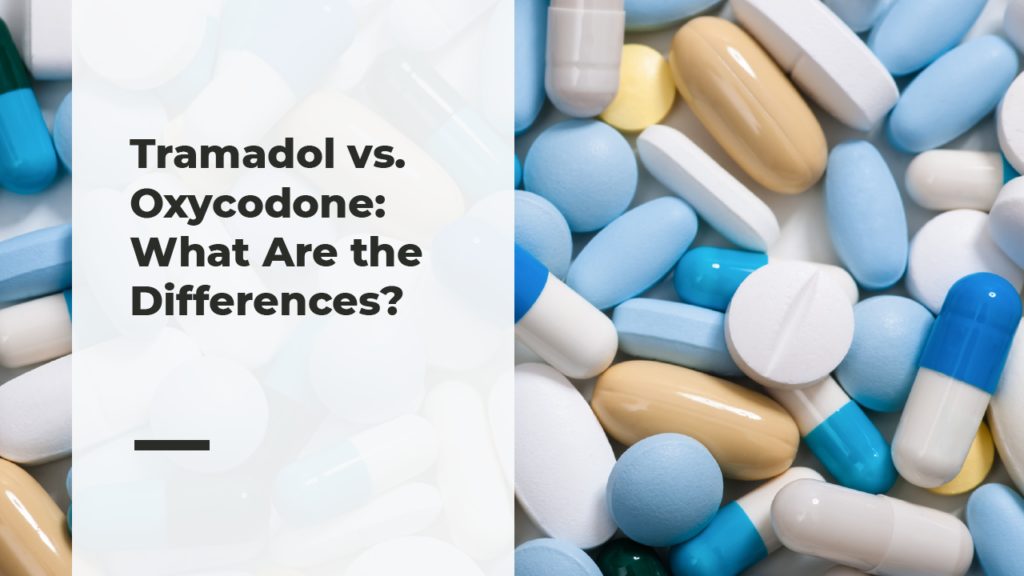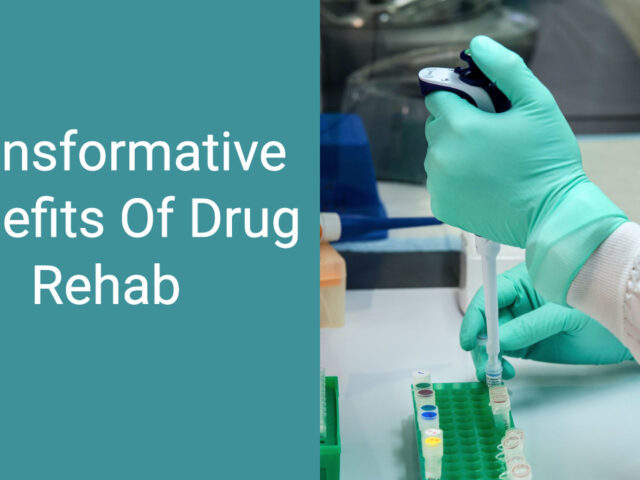“Life doesn’t get easier or more forgiving, we get stronger and more resilient.”
~ Steve Maraboli, Life, the Truth, and Being Free
Oxycodone and tramadol are two medications commonly used to treat moderate to severe pain. Your health care provider may prescribe either drug for you to help manage acute pain after surgery or to relieve chronic pain caused by conditions like cancer.
Both oxycodone and tramadol belong to the opioid analgesics class of medication.1 These drugs inhibit the release of neurotransmitters before they can travel to the brain, reducing pain. Because opioids interact with the brain and central nervous system, they can cause extreme feelings of euphoria. As a result, many users become addicted to them.
While oxycodone and tramadol work similarly to decrease pain, there are a few key differences between the two medications. Read on to learn about how these drugs compare.

What Are the Differences Between Oxycodone and Tramadol?
There are several significant differences between oxycodone and tramadol. Your healthcare provider will compare these medications to decide which drug is most appropriate to treat your pain.
Three important distinctions between oxycodone and tramadol are:
- Drug Classification: The United States Federal Drug Administration has classified oxycodone as a Schedule II controlled medication.2 The government strictly regulates drugs in this category because they have a high risk of causing users to develop a physical or psychological dependency. By contrast, the FDA classifies tramadol as a Schedule IV controlled medication, which means the agency considers the drug to have a low risk of abuse and dependence.
- Mechanism of Activism: Oxycodone relieves pain by binding directly to the mu opioid receptor (MOR) and causing analgesia, or the inability to feel pain.3 In comparison, tramadol functions as a prodrug instead of binding directly to the MOR. This means that metabolizing the drug causes analgesia, not the tramadol itself. As a result, tramadol decreases the risk of causing euphoria when taken in non-prescribed ways and may be less vulnerable to abuse than oxycodone.4
- Rate of Misuse: Because tramadol functions differently than other opioids, people misuse it at lower rates. In 2017, Americans misused approximately 4.6% of tramadol prescriptions. In the same year, 8.2% of oxycodone prescriptions were misused. In other words, Americans misused oxycodone prescriptions at almost twice the rate of tramadol.5
What Is Oxycodone and Why Is It Prescribed?
Oxycodone is a legal prescription opioid agonist used to treat moderate and severe pain. The FDA recommends that prescribers only use oxycodone after other less powerful medications have failed to adequately treat pain.3
This medication comes in several formulations. Immediate-release oxycodone is available in capsule or tablet form.6 The capsule is only available in 5 mg, while the tablet comes in 5 mg, 10 mg, 15 mg, 20 mg, and 30 mg. Prescribers should start with a low dose of 5 to 15 mg and slowly increase the dosage until adequate pain management is achieved.
As the name suggests, immediate-release oxycodone acts quickly and has a relatively short duration. The drug takes effect within 10 to 30 minutes of ingestion and will relieve pain for three to six hours on average.
Oxycodone is also available in an extended-release version known by the brand name OxyContin.7 This formulation provides around-the-clock pain relief by releasing medication slowly into the bloodstream. Each dosage lasts approximately 12 hours, allowing the patient to receive the same level of pain relief while ingesting the medication less frequently.
Oxycodone should only be taken orally as prescribed by your physician. Common ways to abuse and misuse this medication include chewing or crushing tablets, dissolving the medication in water and injecting it, or snorting it. These methods release the opioid uncontrollably in your system, causing an intense high and potentially leading to overdose and death.
Oxycodone Side Effects
If you take oxycodone or OxyContin, you may experience side effects ranging in severity from mild symptoms to a fatal overdose. You can develop an adverse reaction even if you take this medication as prescribed. However, the risk of having severe side effects increases if you misuse oxycodone.
Common side effects that occur for more than 5% of patients who take oxycodone include:6
- Asthenia, or physical weakness
- Constipation
- Dizziness
- Dry mouth
- Headache
- Itching
- Sweating
- Vomiting
Less frequently, users experience side effects like:
- Diarrhea
- Drowsiness
- Glossitis, or inflammation of the tongue
- Hallucinations
- Heart palpitations
- Photosensitivity
- Sedation
- Seizures
Often, these side effects will diminish over time with continued use of oxycodone. However, if you develop mild or severe side effects that persist for several days, you should report these symptoms to your healthcare provider.
You can also experience an overdose after taking oxycodone. Factors that increase your chances of suffering an overdose include accidentally taking an extra dose, mixing the medication with other risky substances, or using a higher dosage than prescribed. Symptoms of an oxycodone overdose include:8
- Blue fingernails and lips
- Clammy or pale face
- Inability to wake up or talk
- Limpness
- Slow breathing or heart rate
If you see someone experiencing an oxycodone overdose, contact 911 immediately for emergency assistance. If you have naloxone available, you should administer it promptly while waiting for emergency services.
Long-Term Effects of Oxycodone Use
If you use oxycodone over an extended period—especially in ways not approved by your physician—you may experience severe long-term effects. Mixing oxycodone with substances like alcohol and other medications can increase your chances of experiencing harmful long-term effects.
Examples of long-term effects of oxycodone usage include:
- Liver Damage: If taken in excessive doses or with acetaminophen, oxycodone can cause hepatotoxicity or acute liver injury. The risk of liver damage rises when taking opioid-acetaminophen combination medications that contain over 325 mg of acetaminophen. As a result, these medications have been discontinued.9
- Neonatal Opioid Withdrawal Syndrome: If an individual uses oxycodone long-term while pregnant, the fetus may become dependent on the medication. After birth, the infant can suffer from a potentially life-threatening opioid withdrawal. Typically, the infant will receive opioid replacement therapy with oral morphine or methadone to help them wean off the drug.10
What Is Tramadol and Why Is It Prescribed?
Tramadol, also known as Conzip or Ultram, is a legal synthetic opioid used to treat moderate to severe pain.11 This medication has surged in popularity in the last decade. For instance, research shows that tramadol use during emergency department visits increased by 70.6% between 2007 and 2018.12
This prescription medication comes in several formulations:
- Extended-release capsule: One dose every 24 hours
- Extended-release tablet: One dose every 24 hours
- Immediate-release tablet: One dose every four to six hours as needed
- Liquid solution: One dose every four to six hours as needed
Tramadol functions as a mu-opioid agonist that reduces pain by altering the brain and nervous system. As a result, some people may abuse or misuse the drug by taking it more frequently than prescribed or by misusing the medication. For example, users may break, chew, cut, inject, or snort tramadol to accelerate the release of the drug. These actions can lead to severe consequences like overdose and death.13
Tramadol Side Effects
Like many prescription medications, tramadol can cause adverse reactions ranging from mild to severe. Even if you take tramadol precisely as prescribed, you may experience unpleasant side effects. However, the chances of experiencing a serious adverse reaction increase if you misuse or abuse this medication.
Common side effects of tramadol include:14
- Constipation
- Dry mouth
- Flushing
- Headache
- Insomnia
- Itching
- Vomiting
More rarely, tramadol also causes adverse reactions like:
- Adrenal insufficiency
- Allergic reactions like bronchospasms and hives
- Hypotension
- Respiratory distress
- Seizures
- Serotonin syndrome
If you develop unpleasant side effects after ingesting tramadol, you should consult with your physician.
Even though tramadol is less potent than oxycodone, you can still overdose on it, especially if you misuse the medication. Symptoms of a tramadol overdose include:
- Confusion
- Extreme tiredness
- Shallow breathing
Contact 911 immediately if you believe that you have overdosed on tramadol.
Long-Term Effects of Tramadol Use
Like oxycodone, tramadol can also cause serious long-term effects, especially if you misuse this drug or combine it with other substances. To reduce your risk of developing long-term effects, you should only use tramadol as prescribed by your healthcare provider.
The long-term effects of tramadol include:15
- Alzheimer’s disease
- Parkinson’s disease
- Seizures
- Serotonin syndrome
These effects typically occur when users take tramadol for an extended period. Limiting this medication to short-term use can reduce your risk of developing these neurological disorders.
Risks of Oxycodone and Tramadol Usage
Both oxycodone and tramadol can positively impact the lives of people suffering from daily moderate to severe pain. However, like all opioids, these prescriptions can also cause adverse effects, such as dependence and overdose.
Oxycodone and Tramadol Withdrawal, Dependence, & Addiction
If you try to halt or reduce your use of oxycodone or tramadol abruptly, you may experience opioid withdrawal. The chances of withdrawal increase if you take these medications over an extended period or in high doses.
Symptoms of opioids withdrawals include:16
- Anxiety
- Diarrhea
- Goosebumps
- Insomnia
- Muscle aches
- Sweating
- Vomiting
You can make the process of withdrawing from oxycodone or tramadol easier by consulting with a healthcare provider, who can prescribe medications like buprenorphine and methadone. These drugs can ease opioid withdrawal symptoms.
If you experience withdrawal, it may signify that you have become dependent on oxycodone or tramadol. Some people continue to take these medications past the recommended period to avoid withdrawal, leading to a destructive cycle of abuse and dependency.
Other symptoms of substance abuse disorder include:17
- Continuing to take the drug even after it disrupts your professional or social life
- Investing large amounts of time into getting and recovering from the drug
- Needing to take increasingly higher doses of the drug to feel the effects
- Taking the drug more frequently than your physician has prescribed
Are you concerned that you may have developed a substance use disorder after using oxycodone or tramadol? If so, the good news is that you’re not alone. Rehabilitation professionals can help you overcome opioid dependency and live a healthier, more enjoyable life.
Contact our helpline today to talk to a qualified recovery specialist about your options.
Resources
- National Library of Medicine. (2022, May). Opioid Analgesics.
- United States Drug Enforcement Administration. Drug Scheduling.
- Federal Drug Administration. (2019, October). Oxycodone Hydrochloride Capsules for Oral Use, CII.
- Postgrad Medicine.(2015 December). An Overview of Prodrug Technology and Its Applications for Developing Abuse-Deterrent Opioids.
- Substance Abuse.(2020). Misuse of Tramadol in the United States: An Analysis of the National Survey of Drug Use and Health 2002-2017.
- National Library of Medicine. (2022, March). Oxycodone.
- Federal Drug Administration. OxyContin HCI Label.
- MedlinePlus. Opioid Overdose.
- National Library of Medicine. (2020, November). Oxycodone.
- Cold Spring Harb Perspect Med.(2021, March). Neonatal Opioid Withdrawal Syndrome (NOWS): A Transgenerational Echo of the Opioid Crisis.
- MedlinePlus. Tramadol.
- The Journal of Emergency Medicine. (2022, March). Tramadol Use in United States Emergency Departments 2007-2018.
- Federal Drug Administration. Ultram.
- Federal Drug Administration. Ultram ER Medication Label.
- CNS Neurol Disord Drug Targets. (2019). Neurobehavioral Consequences Associated with Long Term Tramadol Utilization and Pathological Mechanisms.
- MedlinePlus. Opiate and Opioid Withdrawal.
- DSM Library. Substance-Related and Addictive Disorders.










